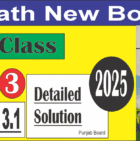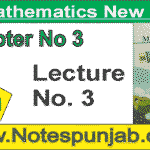9th physics 2025 Chapter4 | Short Question Answer
9th physics 2025 Chapter4 Short Answer Question
4.1 Define like and unlike parallel forces.
We call parallel forces acting in same direction ” like parallel forces ” and those acting in opposite direction ” unlike parallel forces’.
====================================================================================
4.2 What are rectangular components of a vector and their values?
We resolve a force into two components that are perpendicular to each other. We call these components as perpendicular or rectangular components of the force.
$$Horizontol\;component\\is\;represented\;by\;F_x$$ $$F_x=F\;Cos\theta$$
$$Vertical\;component\\is\;represented\;by\;F_y$$ $$F_y=F\;Sin\theta$$
====================================================================================
4.3 What is the line of action of a force?
The line along which the force acts is called the line of action of the force.
====================================================================================
4.4 Define moment of a force. Prove that
$$\tau\;=\;rF\;Sin\theta$$ where Ɵ is angle between r and F.
Moment of the force or torque is defined as the product of the force and the moment arm.
Let a force F is applied on an object at point P which is at a distance r from the origin.
$$Angle\;between\;r\;and\;F\;is\;\theta.\\Horizontal\;and\;vertical\\components\;of\;force\;F\\are\;F\;Cos\theta\;and\;F\;Sin\theta\\respectively.$$
There will be rotation only due to vertical component of force and no rotation due to horizontal component of the force because the line of action of horizontal component of force will pass through the origin.
We call perpendicular distance from the line of action of force to the origin the moment arm, denoted by r.
$$Torque=Moment\;arm\times force\\\tau\;=\;r\;F_y\\\tau\;=\;r\;F\;S\mathrm{in}\theta\;\\$$
====================================================================================
4.5 With the help of a diagram, show that the resultant force is zero but the resultant torque is not zero.
Two equal and opposite parallel forces produce torque. These two forces having same magnitude and opposite direction will give us zero resultant force.

====================================================================================
4.6 Identify the state of equilibrium in each case in the figure given below.

First two objects are in unstable equilibrium and last one is in neutral equilibrium.
====================================================================================
4.7 Give an example of the body which is moving yet in equilibrium.
A car which is moving on a straight road at constant speed is in dynamic equilibrium.
====================================================================================
4.8 Define centre of mass and centre of gravity of a body.
Centre of mass:- Centre of mass of a body is that point where the whole mass of the body is assumed to be concentrated.
Centre of gravity:- Centre of gravity is that point where total weight of the body appears to be acting.
====================================================================================
4.9 What are two basic principles of stability in physics which are applied in designing balancing toys and racing cars?
Two basic principles of stability in physics are centre of mass and centre of gravity.
In balancing toys, their centre of gravity always remain below the pivot point. If we disturb the toys in any direction we raise their centre of gravity making them unstable for a moment.It comes back to its initial stable position by lowering its centre of gravity.
In racing car, we keep its centre of mass as low as possible. We also increase its base area. By keeping the wheels out side of the main body, we also increase its base area.
====================================================================================
4.10 How can you prove that the centripetal force always acts perpendicular to velocity.
The direction of the tangent at each point on a circle is different, therefore the velocity of an object moving with uniform speed in a circle is changing constantly. An object moving with uniform speed in a circular path always requires a force perpendicular to its direction of motion. This force is centripetal force.
====================================================================================
Check! Some important links below




